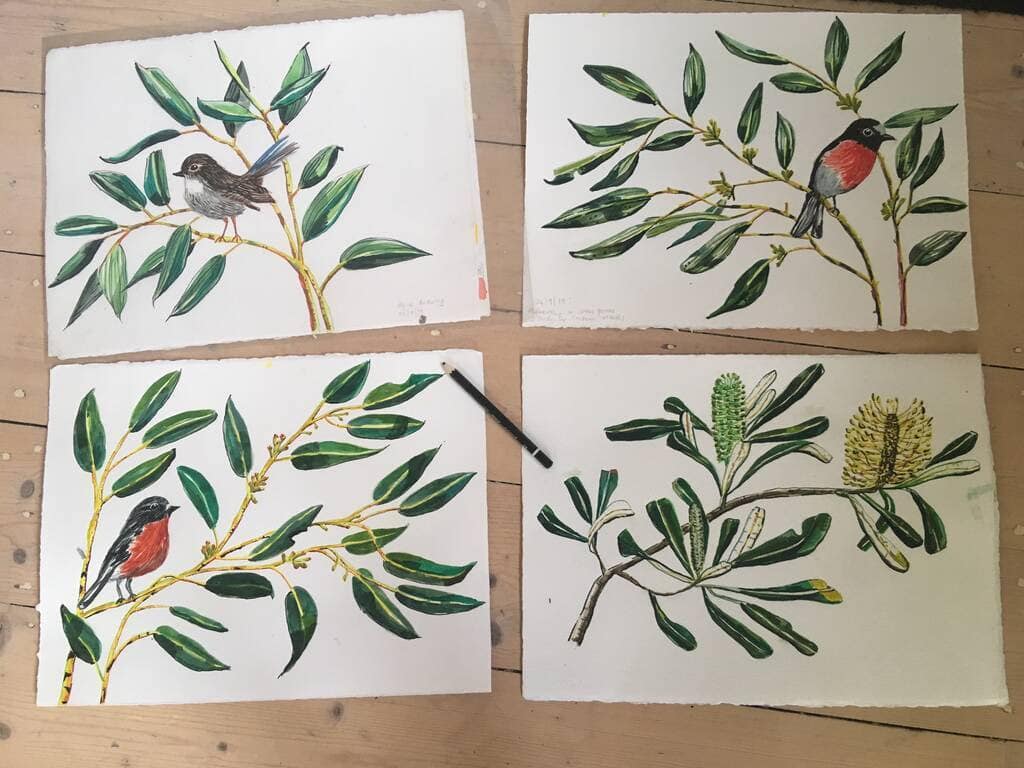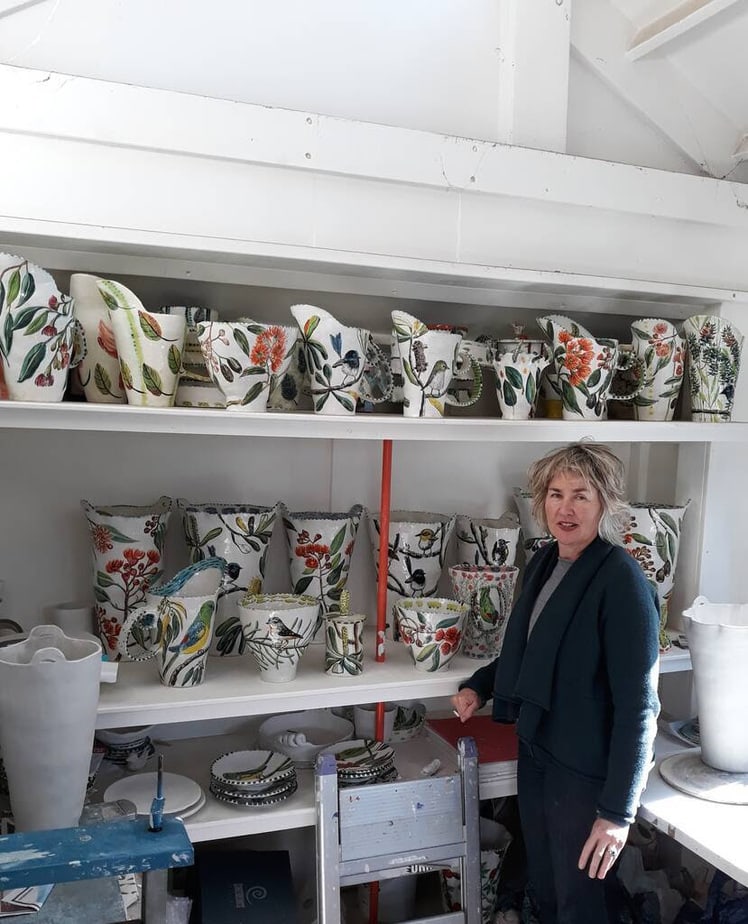Fiona Hiscock’s practice emerges from a long historical tradition of utilitarian ceramics which use nature for decorative inspiration. Oversized, hand-built vases, pitchers, bowls and wall discs provide a canvas upon which the artist depicts the life cycle of botanical specimens, insects and birds, allowing her abiding interest in the natural world to flourish. These ceramic objects depict a range of location specific species including Banksia Serrata which grows along the eastern Victorian coastline and Snow Gum found in high country along with bird species found in Victoria.
In the below interview, we are delighted to share some insights into Fiona Hiscock's studio practice.
GS: You have worked in ceramics for more than three decades and your practice is informed by a long historical tradition of utilitarian ceramics. Can you explain how that began and how it has evolved?
GS: You have worked in ceramics for more than three decades and your practice is informed by a long historical tradition of utilitarian ceramics. Can you explain how that began and how it has evolved?
FH: Thanks for the invitation to go right back to the beginning! While I always loved making ceramics, I didn’t immediately go to art school at the end of year 12. Instead, I studied Fine Arts at Melbourne Uni and did a double major in art history. By the time I commenced studying ceramics at the end of my initial BA, I was completely versed in just about every art movement from the Renaissance to Modernism. When you know this much about art history, it can be very difficult to know how to locate your own practice.
Starting with ceramics was actually an easy choice for me. It’s what I had really wanted to do when I finished school and it felt less overwhelming. I was very much drawn to making useful, somewhat humble utilitarian objects. The key though, given my art history studies, was an interest in narrative, and I always wanted my ceramic objects to act as a canvas, or a device for story-telling and painting. This meant flipping ideas of scale, and giving the object a presence or stature that meant it could not be ignored, or put away in a cupboard.
I was also aware that most of the art history I studied described paintings made largely by men. Ceramics however, speaks of the feminine. We tend to associate vessels, domestic objects and crockery with the home, and by implication, with women. This felt like a better fit for me, and an entry point to a broader perspective.
Starting with ceramics was actually an easy choice for me. It’s what I had really wanted to do when I finished school and it felt less overwhelming. I was very much drawn to making useful, somewhat humble utilitarian objects. The key though, given my art history studies, was an interest in narrative, and I always wanted my ceramic objects to act as a canvas, or a device for story-telling and painting. This meant flipping ideas of scale, and giving the object a presence or stature that meant it could not be ignored, or put away in a cupboard.
I was also aware that most of the art history I studied described paintings made largely by men. Ceramics however, speaks of the feminine. We tend to associate vessels, domestic objects and crockery with the home, and by implication, with women. This felt like a better fit for me, and an entry point to a broader perspective.
GS: Your ceramic vessels act as a canvas for the depiction of a range of location specific species from the eastern Victorian coastline through to those found in Arnhem land. How do you select your subject matter? What is the importance of flora and fauna in your practice?
FH: My work has been about plants and the animals who cohabit with particular species, for the last 20 years. Growing up in rural Victoria, in an old goldfields house, I was first interested in painting the plants early settlers or colonists brought with them to Australia, plants deemed at that time, necessary for survival in what was considered a harsh environment. I quickly became more interested in the weeds that accompanied those species, particularly noting in times of drought that the weeds were thriving, and changing the Australian environment as they spread.

Fiona's trip to the Northern Territory. Post Christmas lunch happiness: Judith Pungarta Inkamala Hayley Panangka Coulthard, Rona Panangka Rubuntja
As a white person, I didn’t feel that I had permission or authority to paint native species as I was too aware of my colonial past. A trip, however, to a well-established Banksia woodland along the East Victorian coast changed that, and I started to get heart palpitations encountering Banksia Serrata for the very first time.
The irony of this personal discovery wasn’t lost on me – it was after-all, the first Banksia ‘discovered’ and identified by Joseph Banks, the London Botanist who was part of the Endeavour in 1788. At this time, I was about to turn 50 and I knew I had to obtain permission from the traditional owners of the land before I could start painting their plants.
I travelled and stayed with a very remote Yolnu community in the Northern Territory and asked the women there for permission to get out my paints. They gave me five different names for their banksia, which looked a lot like Banksia Serrata but was slightly different in habit and leaf spread. The community picked armfuls of plants for me to paint during my time with them and I return from that trip unable to depict anything other than Australian species.
The irony of this personal discovery wasn’t lost on me – it was after-all, the first Banksia ‘discovered’ and identified by Joseph Banks, the London Botanist who was part of the Endeavour in 1788. At this time, I was about to turn 50 and I knew I had to obtain permission from the traditional owners of the land before I could start painting their plants.
I travelled and stayed with a very remote Yolnu community in the Northern Territory and asked the women there for permission to get out my paints. They gave me five different names for their banksia, which looked a lot like Banksia Serrata but was slightly different in habit and leaf spread. The community picked armfuls of plants for me to paint during my time with them and I return from that trip unable to depict anything other than Australian species.
So, I spend as much time as I can in the natural world. I walk, camp and observe particular trees of interest to me, and the birds and insects that live within the confines of a particular species. If feel it is extremely important for me as an artist to paint the Australian environment and highlight it’s beauty and value at a time when it seems increasingly under threat from land clearing, drought and fire. I’ve also seen at first hand how traditional Aboriginal cultural burning practices are much gentler and effective as an on-going management technique, and able to bring a better balance to a healthy ecosystem.

Fiona Hiscock's watercolour studies on paper, 2019
GS: The ceramic medium is technical, with many stages involved in the production. Can you tell us a little about your process?
FH: These pots are hand built using the coil method. When leather hard, they are carved and smoothed, and a porcelain slip is applied to provide a pure white painting surface. Once paper dry, they are painted with stains, ochres, and pigments, which are often mixed by hand. They are fired twice to stoneware temperatures (1180 degrees) and are finished with a clear earthenware gloss. I take a lot of photographs of plants and make watercolour paintings on paper prior to commencing to paint on clay. It’s difficult to make mistakes with ceramic stains – they leave a trace, so I prefer to become as comfortable as I can with the plants I’m choosing to paint prior to committing images onto the clay.

The works for this show commenced prior to the bush fires and were in response to particular trees and plants that had caught my eye over the year. Once the fires hit, I became obsessed with what it would be like to survive as a bird without vegetation and food, and so the works are a mix of the before and the after. Most recently, they depict plants in parks that are local to where I live and the increasing number of birds that seem to have puffed out their feathers during this Covid-19 time of cleaner air and a quieter landscape.

Fiona with her works fresh from the kiln, 2020
The works for this show commenced prior to the bush fires and were in response to particular trees and plants that had caught my eye over the year. Once the fires hit, I became obsessed with what it would be like to survive as a bird without vegetation and food, and so the works are a mix of the before and the after. Most recently, they depict plants in parks that are local to where I live and the increasing number of birds that seem to have puffed out their feathers during this Covid-19 time of cleaner air and a quieter landscape.
GS: Your highly anticipated new body of work is more ambitious in scale than ever before. Why has scale become important to you?
FH: The scale of the work has increased along with my awe and admiration for the environment. And I like giving these objects a stature and presence they would not ordinarily command as objects designed primarily for everyday use. The scale also allows me to tell the whole life story of the plant on the one vessel – bud, flower, spent bloom and leaves. There’s a lot of room to move and I like to encourage the eye to wander over the whole.
GS: And finally, where do you see your practice moving towards? What can we expect to see from you in the next five years?
FH: This is really difficult to answer. I love doing what I am doing now, and know that each time I go somewhere new, there are more plants to paint and birds to depict. I feel it’s my duty as an artist to keep bringing our attention back to the natural world, as we won’t survive as a species unless we look after the planet.
Working with and learning from traditional owners is the key to me, and I know I will continue to work collaboratively with various Aboriginal arts communities in a mutual exchange and ongoing dialogue. But on a lighter note, I’ve started playing with colour a lot more, and experimenting with imagery to move it into a more imaginative and intuitive space.
Working with and learning from traditional owners is the key to me, and I know I will continue to work collaboratively with various Aboriginal arts communities in a mutual exchange and ongoing dialogue. But on a lighter note, I’ve started playing with colour a lot more, and experimenting with imagery to move it into a more imaginative and intuitive space.

